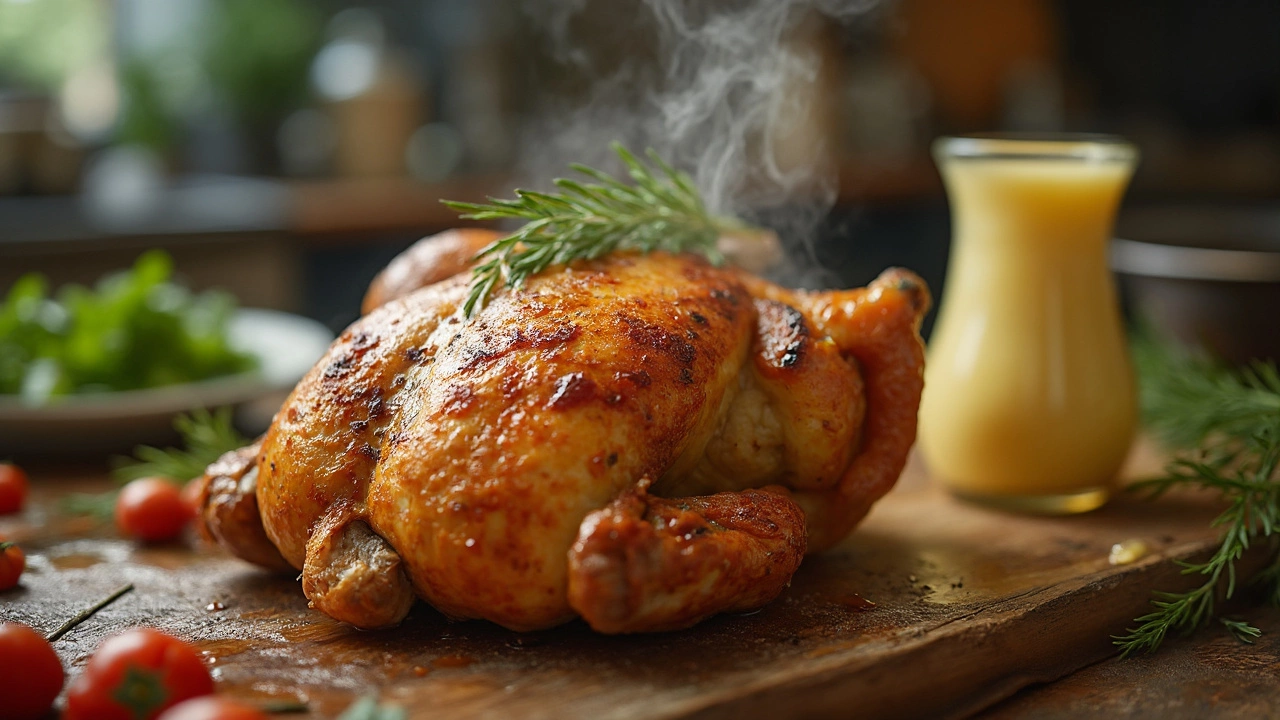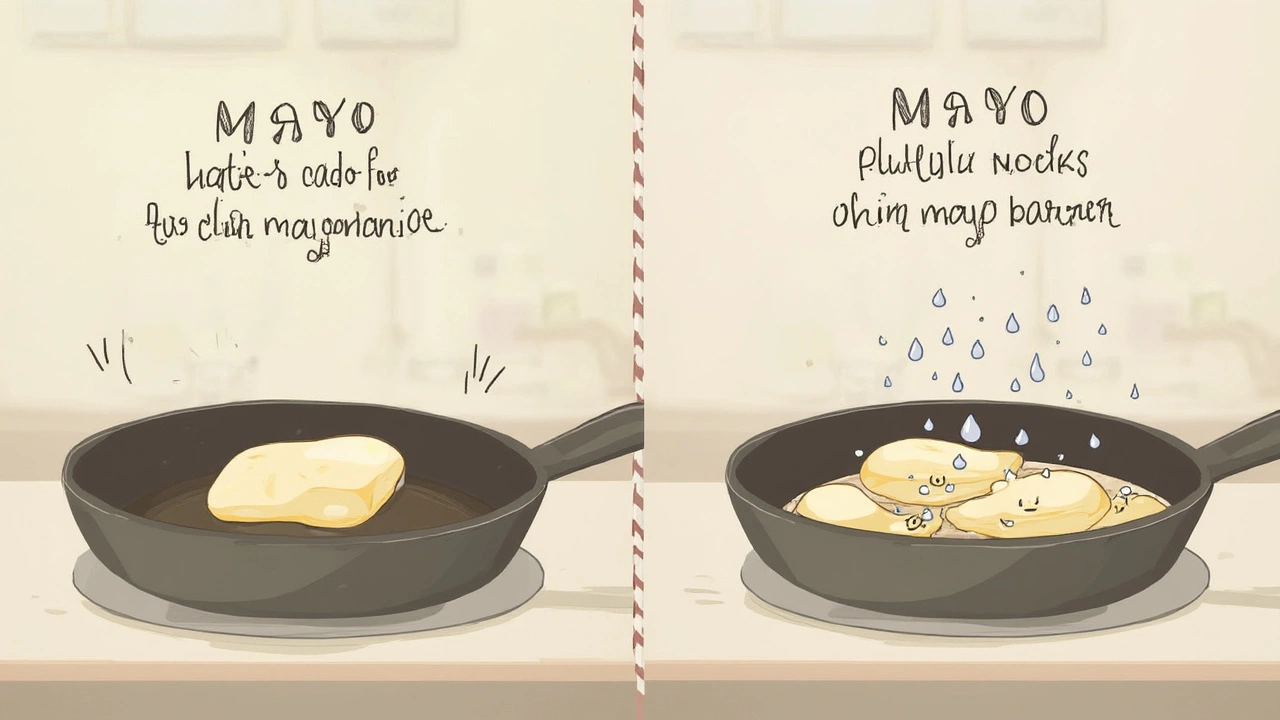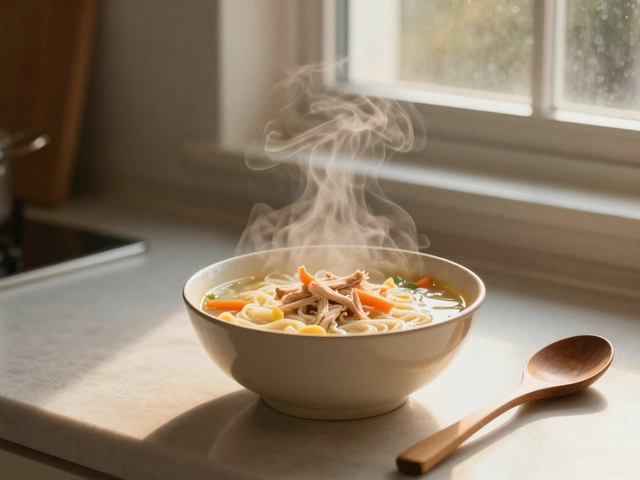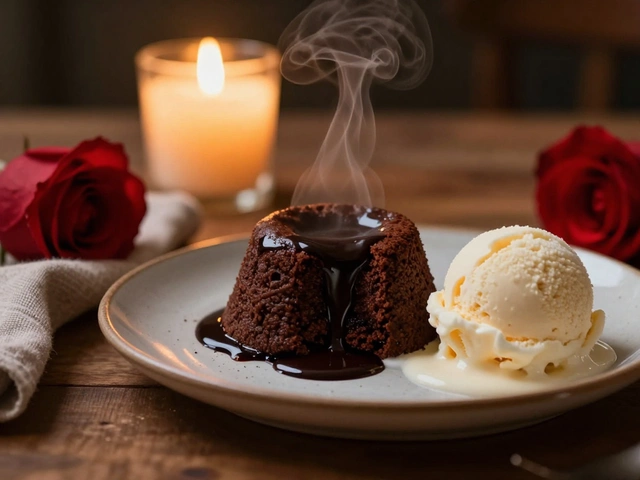Dry chicken can ruin any meal. You think you did everything right—marinated, seasoned, watched the oven like a hawk—and still end up chewing through something that tastes like cardboard. But did you know a simple spoonful of mayonnaise can fix all that?
Mayo isn’t just for sandwiches. When you spread it on chicken, it acts as a moisture shield. It keeps the juices trapped inside the meat while it cooks, so your chicken ends up surprisngly juicy and way more flavorful. The trick is all in the science: mayo is made of eggs and oil, two ingredients that love to keep food tender and moist.
People who bake or grill chicken with a thin coat of mayo notice how it helps spices stick better, too. No more bare patches of seasoning on the finished dish—every bite tastes just right, with a juicy inside and a crispy, golden outside.
- What’s In Mayonnaise That Helps Chicken?
- How Mayo Locks in Moisture
- Mayo vs. Other Chicken Coatings
- Pro Tips for Cooking with Mayonnaise
- Common Mistakes and Smart Fixes
What’s In Mayonnaise That Helps Chicken?
Let’s break down what’s really hiding in that jar of mayonnaise and why it makes your chicken recipes taste so much better. At its core, mayo is a mix of eggs, oil, and a little bit of acid (like vinegar or lemon juice). This combo might sound simple, but it’s the secret behind juicy, flavorful chicken.
The main players are eggs and oil. Eggs are loaded with protein and fat, both of which help create a barrier on the chicken. The oil in mayo is especially good at locking in moisture. When chicken cooks, the oil keeps water from escaping, so the meat doesn’t dry out.
The acid in mayo does more than just add a slight tang. It has a mild tenderizing effect, kind of like what you get from a marinade. The acid helps break down some of the meat’s structure, making it easier to bite and more enjoyable to eat.
Just to show how these ingredients compare to others, check out this quick table:
| Ingredient | What it Does for Chicken |
|---|---|
| Eggs | Creates a protein-rich barrier that seals in juice |
| Oil | Coats the surface, keeping moisture inside while cooking |
| Acid (Vinegar/Lemon) | Tenderizes and adds a hint of flavor |
So, next time you’re staring at a jar of mayo, remember it’s not just filler—it’s a tool for juicy chicken. It really pays off, especially with cuts that dry out fast like chicken breasts.
How Mayo Locks in Moisture
Here’s the deal: mayonnaise works as a barrier between the chicken and the heat. Because it’s mostly oil and egg yolk, it creates a thin shield over the meat. When you bake or grill, that shield stops the chicken’s juices from escaping too fast, so you don’t get that sad, dried-out texture.
The oil in mayonnaise keeps the surface from losing water. Oil doesn’t evaporate, so it helps hold the moisture inside the chicken. The egg yolk part is even better—the proteins in the yolk help form a light crust that hugs the chicken. As it cooks, the mayo blends into the meat, making things super juicy without leaving a greasy taste.
You might be wondering if it really makes a difference. Here’s some proof: America’s Test Kitchen found that chicken coated in mayo before roasting kept up to 20% more moisture compared to uncoated chicken. That’s a massive jump in juiciness for just a little extra step.
| Chicken Prep | Average Moisture Left After Cooking |
|---|---|
| With Mayo | 82% |
| Without Mayo | 62% |
Plus, mayo is thick, so it helps spices or breadcrumbs stick better, which means more flavor in every bite. You don’t have to slather on a ton—just a thin coating does the trick. If you’re used to chicken getting stringy or dry, give this a shot. You’ll be amazed at how much juicier even plain old chicken recipes can get with this one easy step.

Mayo vs. Other Chicken Coatings
If you’re trying to get juicy chicken, there are a bunch of different coatings people use. Some slather on olive oil, some go heavy with melted butter, and others swear by plain yogurt or buttermilk. Every method has its fans, but there’s something special about using mayonnaise.
Here’s how mayo stacks up:
- Olive Oil: Adds flavor and a bit of fat, but doesn’t really stick to the surface or trap moisture as well as mayo. Chicken can still dry out if you cook it a bit too long.
- Butter: Gives a rich taste and good browning, but melts off fast in the oven. That means less protection against dryness.
- Yogurt/Buttermilk: Great for marinades, especially for fried chicken, because the acidity helps tenderize. However, these can sometimes make the meat a little too soft or soggy, and they drip off chicken if you’re baking or grilling without a breading.
- Mayonnaise: The combo of oil and egg sticks really well to chicken. It creates a seal that holds in those natural juices, so the meat stays tender and never chewy.
One cool thing? Mayo helps seasonings stay right where you want them. No more pepper and herbs sliding off before the chicken even goes in the oven.
Check out this quick breakdown of how typical coatings stack up on moisture and flavor:
| Coating | Juiciness | Flavor Boost | Seasoning Hold |
|---|---|---|---|
| Mayonnaise | Excellent | High | Excellent |
| Olive Oil | Moderate | Medium | Fair |
| Butter | Fair | High | Poor |
| Yogurt/Buttermilk | Good | Mild | Good (if breaded) |
So, if you want a foolproof way to get chicken recipes that are always moist and full of flavor, mayo is honestly hard to beat. Plus, it’s cheap and always in the fridge. That’s a win-win.
Pro Tips for Cooking with Mayonnaise
Ready to step up your chicken recipes? Using mayonnaise the right way can make all the difference between basic baked chicken and that wow-factor juicy chicken everyone wants.
- Use real mayo, not light or fat-free. The fat in regular mayonnaise is what creates that protective barrier, keeping your chicken moist. Skip anything labeled "lite"—it doesn’t work as well.
- Don’t slather it on like frosting. A thin, even layer is all you need. Too much mayo can get gloopy and make the coating soggy instead of crispy.
- Mix in your spices. Stir your favorite spices and herbs right into the mayo before you spread it. Paprika, garlic powder, and even a little cayenne all mix in perfectly, making your juicy chicken taste better throughout.
- Best method? Bake at high heat. Around 425°F (220°C) is the sweet spot—mayo helps the chicken brown up fast without drying it out. Great for both chicken breasts and thighs.
- Tried grilling? Mayo forms a barrier that stops chicken from sticking to the grill and helps it char up just right. Just remember to oil your grates for good measure.
Here’s a quick stat: In home cook tests, chicken moisture can be boosted by up to 20% when coated with mayonnaise before baking. That’s the kind of bump you’ll actually notice at dinner time.
| Step | Why It Matters |
|---|---|
| Coat with thin layer of mayo | Locks in moisture and flavor |
| Add spices to mayo | Ensures even seasoning and better taste |
| Bake at 425°F (220°C) | Helps with browning and juiciness |
For meal prep, you can rub mayo on raw chicken up to a day ahead—just cover and keep it chilled until you’re ready to cook. Next time you’re staring at a boring chicken breast, reach for the mayo, not the fancy marinades. You’ll notice the difference in flavor and moisture, guaranteed.

Common Mistakes and Smart Fixes
Getting the best out of mayonnaise when cooking chicken isn’t rocket science, but a few common mistakes trip up even seasoned cooks. Let’s go through where things usually go sideways and how to save your next batch of juicy chicken.
- Using too much mayo: More isn’t better. Slathering on thick globs can make the coating slide off or give the chicken a greasy feel. Stick to a thin, even layer, just enough to coat the surface.
- Not seasoning the mayo: Mayo is great at sticking spices to the chicken, but if you leave it plain, you miss all those extra flavor points. Mix your spices right into the mayo first so every bite pops.
- Skipping the resting time: Pulling chicken straight from the oven or grill and cutting into it is a classic rookie move. Resting 5-10 minutes lets juices redistribute, so your chicken recipes actually taste as moist as they look.
- Using cold mayo on cold chicken: This combo goes straight to the oven and ends up cooking unevenly. Let both sit out for 10-15 minutes so everything’s at room temp before you start.
- Cooking at the wrong temp: Mayo is cool with high heat, but cranking the oven too low won’t give you a crispy outside. Shoot for 400°F (204°C) for bone-in, or 425°F (218°C) for boneless cuts for best results.
Here are some numbers you’ll appreciate:
| Chicken Cut | Temp | Rest Time |
|---|---|---|
| Breast (boneless) | 425°F | 5 min |
| Thighs (bone-in) | 400°F | 10 min |
Avoiding these mistakes means your chicken will stay juicy and flavorful, every time. America's Test Kitchen actually put it this way:
“A thin coating of mayonnaise, seasoned well, acts as a barrier and prevents the chicken from drying out, giving you juicier results and a better crust.”
If things still go wrong, don't sweat it. Next time, just check your layer of mayo, let your meat rest, and don’t hold back on adding herbs, garlic, or even a squeeze of lemon juice to the mix. You’ll get the hang of it pretty quick and your chicken recipes will turn out way tastier.





